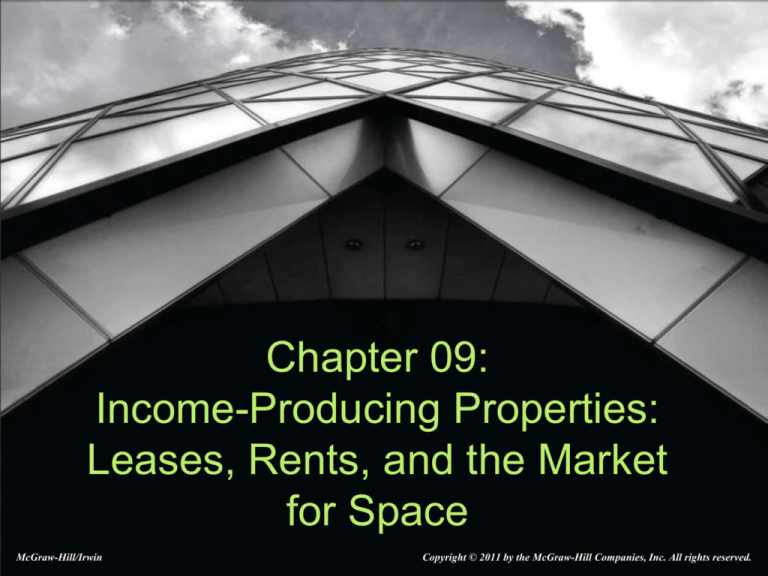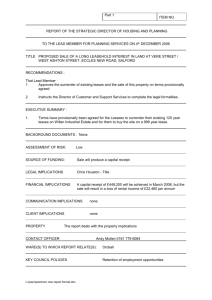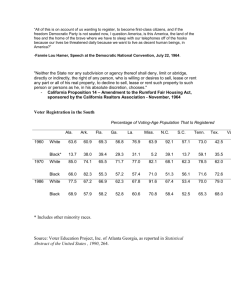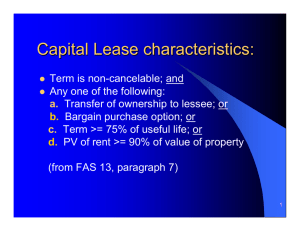
Chapter 09:
Income-Producing Properties:
Leases, Rents, and the Market
for Space
McGraw-Hill/Irwin
Copyright © 2011 by the McGraw-Hill Companies, Inc. All rights reserved.
Property Types
Residential
– Single family houses, condominiums, cooperative
apartments
Income Producing
– Multifamily
– Commercial
Office
Retail
Hotel/motel
– Industrial/warehouse
– Recreational
– Institutional (special purpose)
Mixed Use Developments
9-2
Supply & Demand
Equilibrium Market Rental Rate
– Vacancy Rate
– Supply and Demand
– Short run vs. long-run
– There are different influences on supply and
demand for different product types
9-3
Exhibit 9-2
Rental Market Equilibrium
9-4
Location & User-Tenants
Motivating Factors
– Increase sales
Business type where success requires a higher
revenue stream and heavy pedestrian traffic
– Reduce operating costs
Business type where success is based on a lower
cost structure and large amount of land
9-5
Location & User-Tenants
1. Competition leads to the highest rents in the
most profitable locations and land value
2. Locations will be dominated by clusters of
users with similar revenue or operating
expense structures
3. Locations that are most valued will lead to
the greatest density
4. Some locations are competed for by firms
that are most cost-sensitive
9-6
Popular Business Choice: Leasing
More cost-effective than owning
–
–
–
–
Space requirements
Owning is a heavy capital investment
Stay out of the “real estate business”
Maintain operating flexibility. It’s much easier to lease
new space, or sub-lease excess space based on
staffing levels than it is to buy or sell buildings.
– Maintenance and repair
– If not used, must dispose of excess space
This results in specialized real estate firms.
The exception is for specialized facilities or for
headquarters facilities where there are business
reasons to own instead of lease.
9-7
Real Estate Income
Market Rent
– Outlook for national economy
– Economic base of the area
– Demand
– Supply
Vacancy
– On account of tenant turnover, space is not
always leased even in strong markets.
9-8
Leases
Lessor = Owner, Lessee = Tenant
Underwriting Tenants
– Financial statements
– Credit ratings
– Analyst reports
– Bank relationships
– Existing obligations
9-9
General Contents of Leases
– Parties, Dates, Length
– Base rent
– Deposits
– Condition
– Allowable uses
– Restrictions on assignment or subletting
– Use of common areas and facilities
– Responsibility for maintenance and repair
9-10
General Contents of Leases
– Restrictions on alterations or improvements
– Construction of any expansion by owner
– Eminent domain and any consideration
– Responsibility for payment of specific
expenses by lessee and/or lessor
– Insurance requirements
– Lease renewal options
– Estoppels
9-11
Lease Income
Flat Rent
– No rent change over lease term
Step Up Rents
– Specified rent increases at specified times
Indexed Rents
– Periodic rent adjustment-CPI Index
Percentage Lease
– Rent partially based on sales
– “Breakpoint”
9-12
Leases & Expenses
Gross (full service) leases
– Tenant pays rent only
– Property owner pays all operating expenses
Modified (full service) lease
– Direct “pass-throughs”
– Non-operating expense “pass-throughs”
Leases with operating expense recoveries
– Single net leases, Double net, Triple net
Common Area Maintenance (CAM)
9-13
Effective Rent
Used to compare different leases
– Compute present value of rent stream
– Convert present value to an equivalent level
annuity
Example 9-1:
Consider the following rent schedule
– Year 1 = $12/square foot
– Year 2 = $14/square foot
– Year 3 = $15/square foot
9-14
Effective Rent
Step 1: Compute the present value
C0 = 0
C1
= 12
C2
= 14
C3
= 15
i
= 12
CPT
NPV
= $32.55
9-15
Effective Rent
Step 2:
PV
= $32.55
n
=3
i
= 12
CPT
PMT
= $13.55
This is the effective rent for this rent schedule.
9-16
Effective Rent
Use the same procedure to evaluate all
potential lease alternatives.
This measures the return to the lessor and
cost to the lessee.
9-17
Pro-Forma Cash Flow Statement
Rental Income
+ Other Income
+ Recoveries
- Vacancy and Collection Losses
- Concessions
Effective Gross Income (EGI)
9-18
Pro-Forma Cash Flow Statement
-
EGI
Operating Expenses
Capital Expenditures
Net Operating Income (“NOI”)
Depending on the analyst, capital
expenditures may or may not be including
in the calculation of net operating income.
9-19
Office Leases
Variable terms
Premium & Discounts
Rentable area
Usable area
Load factor
9-20
Industrial Property Leases
Similar to office leases
More individualized for tenant
Term tends to be longer than office leases
Tend to be pass-through
Premiums & Discounts
9-21
Retail Leases
Sales per Rentable Square Foot and Traffic
Counts
Provisions on operations may include limits on
other tenants
Anchor and In-Line Tenants
– Rent Differences
Percentage rent lease
– Breakpoint
– Overage
Common Area Maintenance (CAM)
9-22
Apartment Leases
Shorter Term
Impact of consumer protection laws
Gross Potential Rental Income
– Full occupancy
Loss to Lease
– The concept of loss to lease is that since the leases in
residential real estate are so short, a landlord is
always on the verge of catching up to whatever
market is. The loss to lease shows what this
differential is.
9-23








